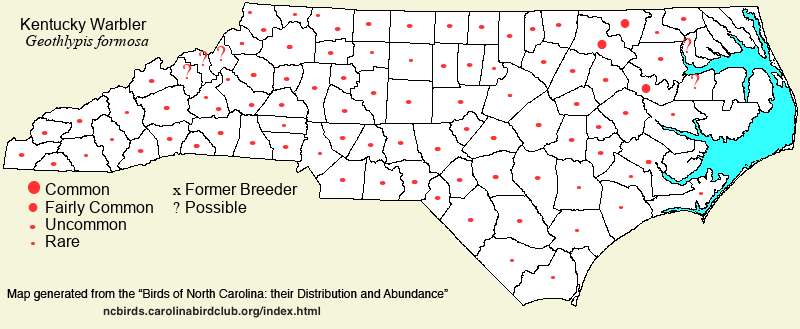 |  |
|
Kentucky Warbler - Geothlypis formosa PARULIDAE Members: | Search Common: Search Scientific: |
|
|
|||||||
| General Comments | In 2011, the Kentucky Warbler was moved from the genus Oporornis to the genus that formerly was used just for the yellowthroat group (Geothlypis). This warbler, unlike so many other geographically named warblers, is actually well-named, as the center of its range and perhaps abundance lies in the Kentucky area. It is a bird of the Eastern deciduous forest, breeding across nearly all of North Carolina, and wintering south of the country. Though a common bird west of the Appalachians, east of the mountains it is nowhere really common. It is almost always found nesting in moist, rich forest, with an abundance of ferns and other herbaceous species, as well as a good shrub zone, beneath a hardwood canopy. Most breed in floodplains, particularly in brownwater ones; it is scarce in blackwater regions such as the Lumber River. In the mountains, where broad floodplains are scarce, the birds do nest on slopes, but usually on lower ones or others that are very rich and lush. It also is scarce near the coast as a breeder, somewhat like the ranges of the Louisiana Waterthrush and Ovenbird. Sadly, in many parts of the state, this species has noticeably declined in the breeding season, especially in heavily populated counties in the Piedmont; Kentucky Warblers fare poorly when bottomland forests are impacted by exotic plants and other small disturbances. | ||||||
| Breeding Status | Breeder | ||||||
| NC BRC List | Definitive | ||||||
| State Status | |||||||
| U.S. Status | |||||||
| State Rank | S3S4B | ||||||
| Global Rank | G5 | ||||||
| Coastal Plain | Summer resident, declining. Generally uncommon over the region as a whole; however, fairly common along most of the Roanoke River floodplain and in the Neuse River "Let-lones" in southeastern Johnston. Closer to the coast, nests east to the Chowan River area and the western portions of most southern coast counties, but generally local as a breeder in coastal counties. Mainly absent as a breeder on the Pamlimarle Peninsula, as well as in the Great Dismal Swamp (North Carolina side), nor does it nest on coastal islands. Rarely noted as a migrant, even along the coast in fall. Mainly late Apr to early Sep; departure dates not well known. Peak counts: | ||||||
| Piedmont | Summer resident; strongly declining in much of the region. Generally uncommon throughout the region. Can be rare in some highly residential or agricultural counties. Most numerous in the eastern portions, though still generally uncommon at best. Mainly late Apr to early Sep, but departure dates not clarified, as silent in fall, and relatively few migrants pass through. Peak counts: | ||||||
| Mountains | Summer resident. Generally uncommon and somewhat local; more restricted in range and habitat than downstate. Rare in many of the northern counties, as the elevation is mostly too high for them. Scarce and often rare between 3,000 feet and 3,800 feet elevation; prefers elevations below 2,500 feet. Mainly late Apr into Sep, but departure dates not overly well known. Peak counts: | ||||||
| Finding Tips |
The species should be found in Howell Woods Preserve (Johnston). It is also rather easily found along the Roanoke River, but accessible places are few and far between, other than by canoeing. ** to *** | ||||||
| Attribution | LeGrand[2024-11-11], LeGrand[2023-04-03], LeGrand[2012-10-03] | ||||||
| NC Map Map depicts all counties with a report (transient or resident) for the species. | Click on county for list of all known species. |
| NC Breeding Season Map Map depicts assumed breeding season abundance for the species. |  |